In today's fast-paced digital landscape, staying ahead of the competition requires precise insights into how your applications and systems perform. For CEOs, CIOs, and CMOs, ensuring optimal performance and reliability is not just a technical concern; it's a business imperative. OpenTelemetry is a powerful tool that can help organizations achieve these goals. This comprehensive introduction aims to educate business leaders on the benefits of adopting OpenTelemetry.
Understanding OpenTelemetry

OpenTelemetry is an open-source project that provides a set of APIs, libraries, agents, and instrumentation to enable observability in your applications. In simpler terms, it helps you understand how your software systems are functioning and how your users are experiencing them.
The Importance of Monitoring and Observability
In today's interconnected world, applications and systems are the backbone of almost every business. They are the conduits through which your customers and partners interact with your products and services. When these systems fail or underperform, the consequences can be severe, including lost revenue, damaged reputation, and frustrated users. Monitoring and observability are the keys to proactively identifying and addressing issues before they escalate.
The Need for OpenTelemetry
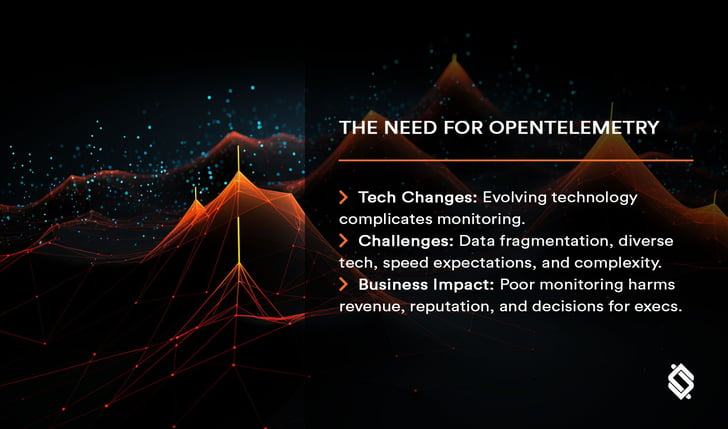
Evolving Technology Landscape
The technology landscape is in a constant state of flux. Organizations are rapidly adopting cloud-native architectures, microservices, and containerization to stay agile and competitive. While these technologies offer numerous advantages, they also introduce complexity in monitoring and observability.
In traditional monolithic systems, monitoring was relatively straightforward. However, in modern distributed environments, applications can be composed of hundreds, or even thousands, of microservices. This complexity makes it challenging to pinpoint the source of issues or to understand the overall health of your application.
Challenges in Monitoring and Observability
The challenges associated with monitoring and observability in modern applications are substantial. These challenges include:
- Fragmented Data: Data is scattered across multiple services and systems, making it difficult to create a unified view.
- Diverse Technologies: Organizations use a mix of programming languages, frameworks, and tools, making it hard to standardize monitoring.
- Shortened Response Time: Users expect instant responses. To meet these expectations, you need to identify and resolve issues quickly.
- Elastic Scalability: Modern applications can scale up or down based on demand, requiring monitoring solutions to be just as flexible.
- Complex Workflows: It's challenging to trace requests as they traverse different services and systems.
Business Implications
For CEOs, CIOs, and CMOs, the business implications of poor monitoring and observability are significant. When applications are slow, unresponsive, or prone to outages, customers can quickly become frustrated and take their business elsewhere. This can result in lost revenue and a tarnished brand image. Additionally, it can hamper the ability to make data-driven decisions, impacting the overall efficiency and growth of the organization.
What OpenTelemetry Does
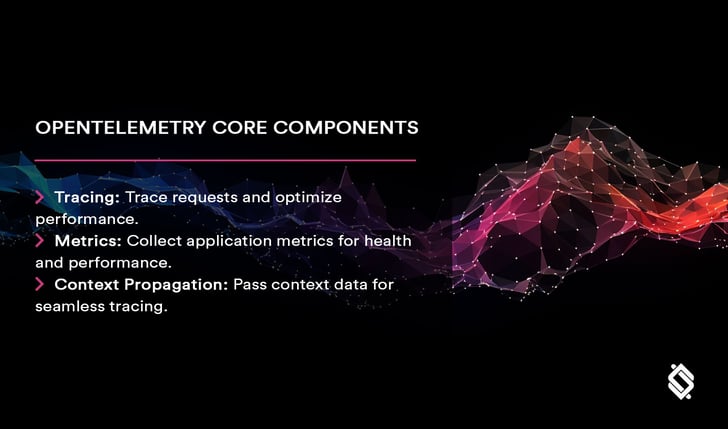
Now that we've established the need for improved monitoring and observability, let's delve into what OpenTelemetry brings to the table.
Core Components
OpenTelemetry consists of three core components:
- Tracing: This component helps you trace the flow of requests as they move through your systems. It provides detailed insights into how long each operation takes, which is critical for optimizing performance.
- Metrics: Metrics are essential for understanding the health and performance of your applications. OpenTelemetry allows you to collect and visualize metrics such as error rates, response times, and resource utilization.
- Context Propagation: This component enables you to pass contextual information across different services, allowing for seamless tracing and correlation of data.
Data Collection and Instrumentation
OpenTelemetry works by instrumenting your code. This means adding specific lines of code to your applications to capture data. Once you've instrumented your code, OpenTelemetry collects and exports this data to various backends, such as observability platforms or data storage systems. This data can then be analyzed, visualized, and used to gain insights into your application's performance.
How OpenTelemetry Works
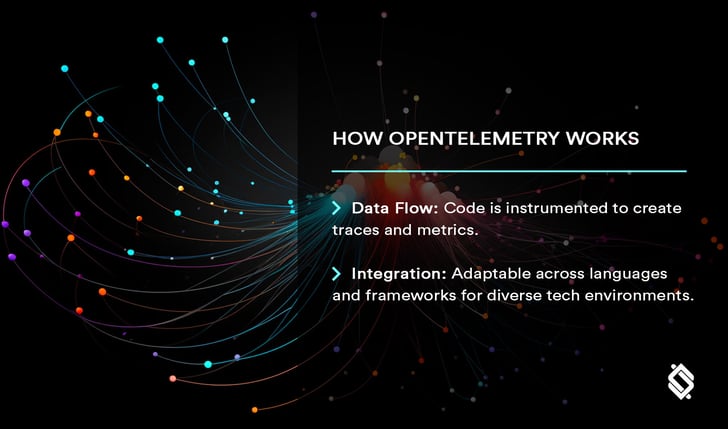
Data Flow and Processing
Understanding how OpenTelemetry works is essential for appreciating its benefits. When you instrument your code with OpenTelemetry, it generates traces and metrics, which are then collected by OpenTelemetry agents or libraries. These agents export the data to observability platforms where it's processed and made available for analysis.
Integrations and Adaptability
OpenTelemetry is highly adaptable and can be integrated with a wide range of programming languages and frameworks. This adaptability makes it a valuable tool in diverse technology environments, which is crucial for businesses that utilize a mix of technologies.
Benefits of OpenTelemetry
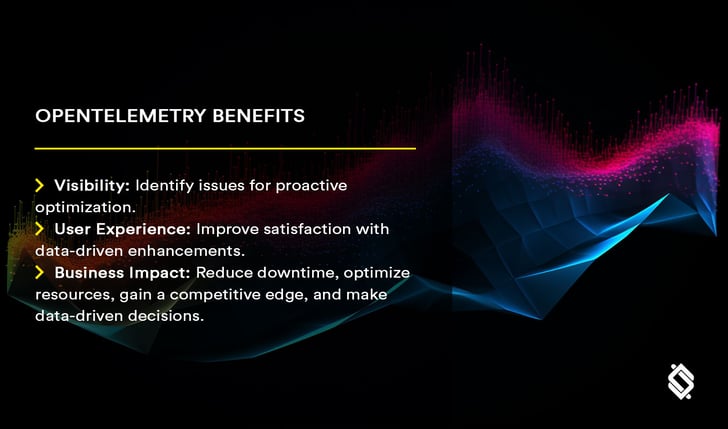
Now, let's explore the benefits of implementing OpenTelemetry in your organization.
Improved Operational Visibility
OpenTelemetry provides a comprehensive view of how your applications are performing. With detailed traces and metrics, you can quickly identify bottlenecks, errors, and other issues. This information is invaluable for operations teams, allowing them to troubleshoot and optimize your systems proactively.
Enhanced User Experience
A smooth user experience is vital for retaining and attracting customers. With OpenTelemetry, you can gain insights into how users are interacting with your applications. You can monitor response times, track errors, and understand the paths users take through your systems. Armed with this information, you can make data-driven improvements that directly impact user satisfaction.
Business Impact
Ultimately, the benefits of OpenTelemetry extend beyond technical improvements. They translate into tangible business outcomes. Here are some of the ways in which OpenTelemetry can have a positive impact on your organization:
- Reduced Downtime: Swift issue resolution leads to reduced downtime, which, in turn, leads to higher customer satisfaction and increased revenue.
- Optimized Resources: By identifying performance bottlenecks, you can allocate resources more efficiently, reducing costs and improving your bottom line.
- Competitive Advantage: Organizations that leverage OpenTelemetry are better equipped to stay competitive in today's rapidly evolving business landscape.
- Data-Driven Decision-Making: OpenTelemetry provides the data needed for informed, data-driven decision-making, enhancing overall efficiency.
Getting Started with OpenTelemetry
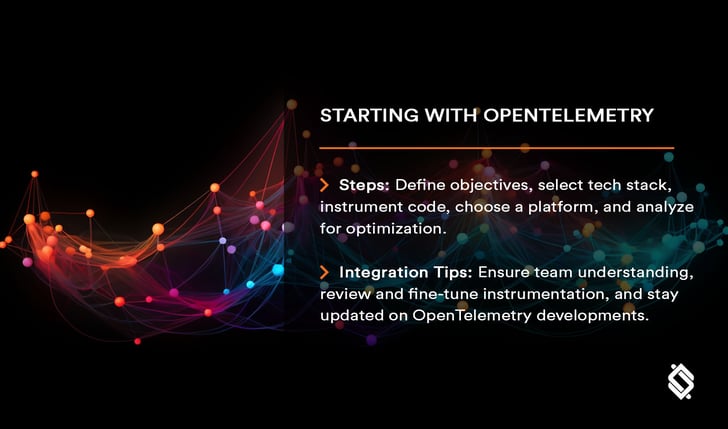
If you're intrigued by the potential benefits of OpenTelemetry for your organization, here's how you can get started:
Implementation Steps
- Define Your Objectives: Start by identifying what you want to achieve with OpenTelemetry. Are you looking to reduce downtime, improve user experience, or optimize resource allocation?
- Select Your Technology Stack: Determine which programming languages and frameworks your organization uses. OpenTelemetry has extensive support for various technologies.
- Instrument Your Code: Work with your development teams to instrument your code with OpenTelemetry. This is a crucial step in capturing the data you need for monitoring and observability.
- Choose an Observability Platform: Select an observability platform that integrates with OpenTelemetry. Many popular platforms support this open-source project.
- Analyze and Act: Once you start collecting data, use it to analyze the performance of your applications. Identify areas for improvement and take action to optimize your systems.
Integration Tips
- Ensure that your teams understand the importance of OpenTelemetry and its impact on the business.
- Regularly review and fine-tune your instrumentation to capture the most relevant data.
- Stay up to date with the latest developments in the OpenTelemetry project to benefit from ongoing improvements and enhancements.
Success Stories
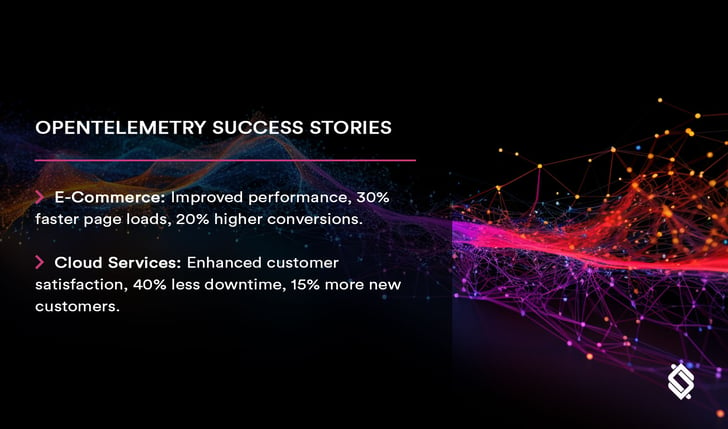
To illustrate the real-world impact of OpenTelemetry, let's explore a couple of success stories from organizations that have embraced this technology.
Success Story 1: E-Commerce Giant
An e-commerce giant implemented OpenTelemetry to improve its website's performance. By capturing detailed traces and metrics, the company identified specific areas of their application that were causing delays. After optimizing these areas, they saw a 30% reduction in page load times, resulting in a 20% increase in conversion rates.
Success Story 2: Cloud Services Provider
A cloud services provider integrated OpenTelemetry into its infrastructure to enhance customer satisfaction. With OpenTelemetry, they could quickly detect and respond to issues, reducing downtime by 40%. This not only improved their reputation but also led to a 15% increase in new customer acquisitions.
The Ongoing Evolution of OpenTelemetry
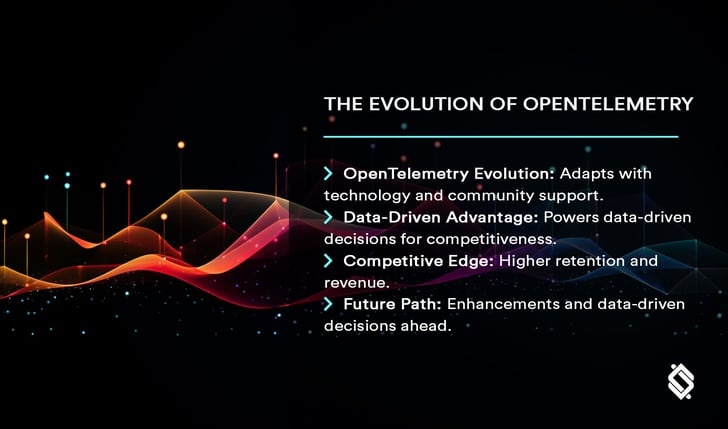
As technology evolves, so does OpenTelemetry. This open-source project is continually improving and adapting to meet the changing needs of modern businesses. It's not just a static tool; it's a dynamic solution that evolves alongside your technology stack.
One of the most exciting aspects of OpenTelemetry is its vibrant community of contributors. This community is dedicated to enhancing the capabilities of OpenTelemetry, expanding its support for new programming languages, and integrating it with additional observability platforms. This means that adopting OpenTelemetry isn't just a one-time investment—it's a commitment to a technology that will continue to deliver value as your organization grows and evolves.
Embracing a Data-Driven Culture
In today's data-driven world, the ability to collect, analyze, and act upon data is a critical differentiator. OpenTelemetry enables organizations to embrace a data-driven culture. It provides the insights needed to make informed decisions, allocate resources efficiently, and maintain a competitive edge. This means having a powerful tool at your disposal to shape the future of your organization.
The Competitive Advantage of OpenTelemetry
In a world where customer expectations are higher than ever, the competitive advantage provided by OpenTelemetry cannot be understated. By leveraging OpenTelemetry, your organization gains a clear advantage over competitors who are still struggling with traditional monitoring and observability approaches. This advantage can translate into higher customer retention, increased revenue, and a stronger market position.
The Road Ahead
As we've explored the world of OpenTelemetry, its benefits, and its potential impact on your organization, it's clear that this is not just a technology but a strategic enabler. For CEOs, CIOs, and CMOs, the road ahead is paved with opportunities to harness the power of OpenTelemetry. It's a journey toward enhanced performance, improved user experiences, and data-driven decision-making.
Conclusion

In conclusion, OpenTelemetry is not just a tool; it's a gateway to a brighter and more competitive future for your organization. By adopting OpenTelemetry, you are taking a significant step toward achieving excellence in a technology-driven world. So, don't wait. Embrace OpenTelemetry and watch your organization thrive in the era of observability and performance optimization. As technology continues to evolve, OpenTelemetry is a valuable asset in staying competitive and meeting the expectations of your customers.
This comprehensive introduction to OpenTelemetry has provided a deep understanding of its significance and benefits. It is a catalyst for transformation, an enabler of data-driven decisions, and a competitive advantage that propels your organization into a new era of excellence. The road ahead is illuminated by the power of OpenTelemetry, and the opportunities it presents are limited only by your imagination. Embrace OpenTelemetry, and lead your organization toward a future of unprecedented success.



